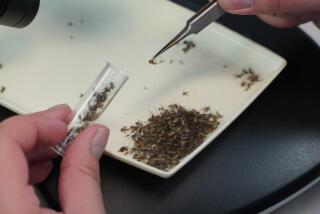Study tallies West Nile’s toll on continent’s birds
- Share via
Since West Nile virus began to spread across North America in 1999, it has ravaged seven different bird populations, according to a study published today.
Of the 20 species included in the study, American crows were the most affected, declining by as much as 45% in some regions from 1998 to 2005. Populations of American robins, chickadees, Eastern bluebirds, blue jays, tufted titmice and house wrens also dropped, the study said.
“West Nile was able to traverse a continent in the avian community and have significant impacts on our most familiar native species, our backyard birds,” said Shannon LaDeau, the study’s lead author and a postdoctoral fellow at the Smithsonian Migratory Bird Center.
The study, published in the journal Nature, also found that populations of 13 species, including the common grackle, the gray catbird and the mourning dove, appeared unaffected by the virus.
Leslie Dierauf, director of the U.S. Geological Survey National Wildlife Health Center, who was not connected with the study, cautioned that there were too many variables, including weather, temperature and habitat destruction, that could drastically change bird populations. She said blaming the bird declines all on West Nile virus could be too simplistic.
Bob Dusek, a wildlife biologist at the center, said the chickadee population, for example, had been growing at record rates and reached a 26-year high just before the arrival of West Nile virus.
“Is the decline the result of the population going up too high, or is it West Nile?” he asked. Dusek said the study was not detailed enough to provide an answer.
West Nile virus, which is primarily transmitted by mosquitoes, is named after the district in Uganda where the disease was first isolated. It circulates mostly among birds, but has also been found in some mammals and reptiles.
The virus first appeared in New York in 1999, and quickly spread west across the country, reaching California in 2002.
In humans, the virus can cause fever, encephalitis and other severe nervous-system diseases. From 1999 to 2006, 962 people have died due to the virus, according to the federal Centers for Disease Control and Prevention. Deaths reached their peak in 2002 with 284. Last year, 177 people died across the country.
The study analyzed data from the North American Breeding Bird Survey, overseen by the USGS’ Patuxent Wildlife Research Center in Maryland.
LaDeau and colleagues analyzed data on five bird species that laboratory tests indicated were highly vulnerable to the virus, 10 species expected to suffer moderate to little impact, and five species not previously studied.
Using data from 1980 to 2005, they calculated the birds’ expected population trends.
Seven species showed significant population declines after the appearance of the virus in 1999, compared with their projected trends, LaDeau said.
The researchers could correlate the population declines with the spread of the virus west and south, she said.
Crows showed the most consistent decline across all regions. The populations of the other six species declined unevenly. Chickadees, for example, fell at least 50% below expected abundance in Maryland, Virginia and through the Northeastern states in 2005, but rose in Illinois.
Three of the affected birds -- blue jays, tufted titmice and house wrens -- appeared to bounce back to expected levels after sharp one- or two-year declines.
Researchers are not sure why that happened, but LaDeau hypothesized that mosquitoes only turned to these species temporarily because West Nile had reduced populations of the birds they preferred.
These species might have also been particularly vulnerable in those years because of other stressors, such as drought, she said.
Though the study did not look at the wider effects of the declines, LaDeau surmised that such large losses could upset the ecological balance in some areas.
She said, for example, that a severe decline of one species could spark declines in another as mosquitoes hunt for more food.
“Mosquitoes have to feed on something,” LaDeau said. “As their priority species decline, it might be another bird species currently not impacted, or humans.”
*
More to Read
Sign up for Essential California
The most important California stories and recommendations in your inbox every morning.
You may occasionally receive promotional content from the Los Angeles Times.













